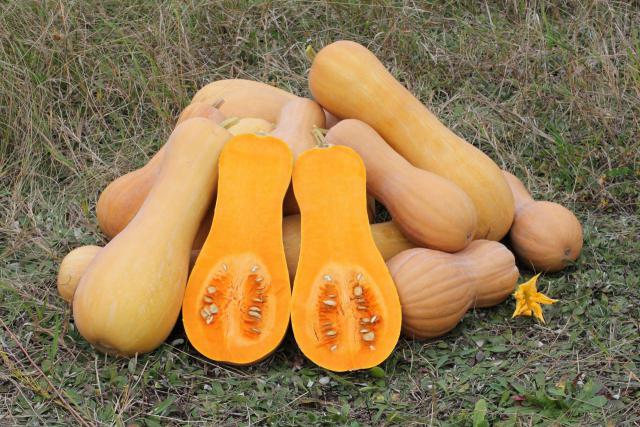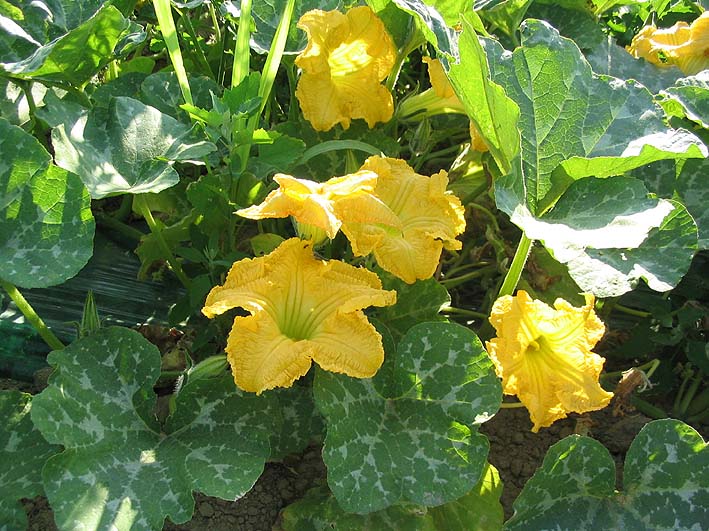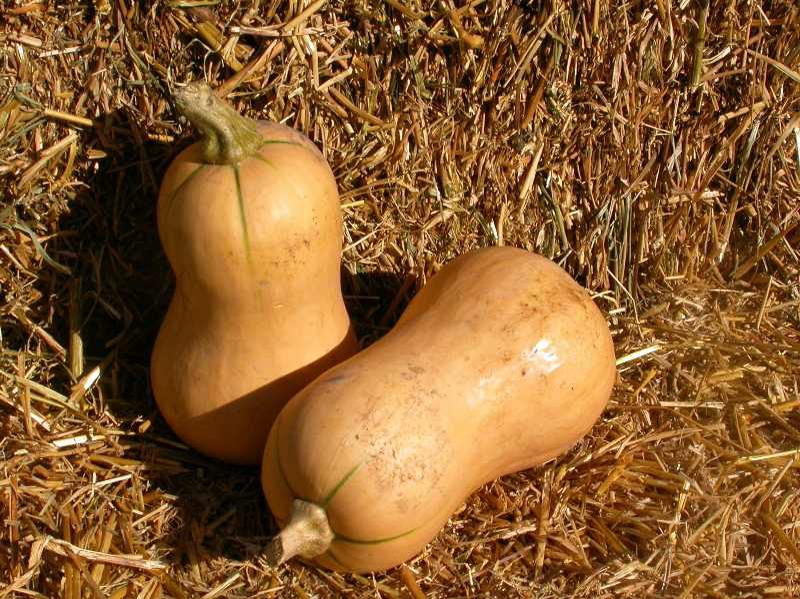Editor’s Note: As the Food as Medicine project has
evolved at the American Botanical Council (ABC), the editors of HerbalEGram
will revisit previous articles in this series and update them with current
research. This effort will hopefully improve the accuracy and relevance of
these articles, in keeping with our commitment to education and empowerment.
Food as Medicine: Butternut Squash was originally published in the March 2015
issue of HerbalEGram.
The basic materials for
this series were compiled by dietetic interns from Texas State University in
San Marcos and the University of Texas at Austin through ABC’s Dietetic
Internship Program, led by ABC Education Coordinator Jenny Perez. We would like
to acknowledge Perez, ABC Special Projects Director Gayle Engels, and ABC Chief
Science Officer Stefan Gafner, PhD, for their contributions to this project.
By Hannah
Baumana and Sarah Edwardsb
a HerbalGram Associate Editor
b ABC Dietetics
Intern (Texas State, 2013)
Overview
Cucurbita
moschata (Cucurbitaceae), which is referred to as butternut, winter,
or pumpkin squash, is a trailing annual with lobed leaves and yellow flowers.1
Mature fruits that are peanut- or bottle-shaped are harvested for their rich
orange flesh and edible seeds. Native to tropical and subtropical regions of
the American continents, butternut squash requires warm climates for
cultivation.1,2 Butternut squash grows
best in rich and well-drained soil in full sun.2 It can be
stored for extended periods, and, in fact, has one of the longest shelf lives of
edible fruits in the Cucurbitaceae family.3
Phytochemicals and Constituents
Butternut
squash contains high amounts of complex carbohydrates and provides vitamin C,
potassium, iron, riboflavin, and magnesium.3 Additionally, butternut
squash is an excellent source of carotenoids such as alpha-carotene, beta-carotene,
beta-cryptoxanthin, lutein, and zeaxanthin. While it is a low-fat food,
butternut squash does contain some healthy fats in the form of alpha-linolenic
acid, a beneficial omega-3 fatty acid.4 Omega-3 fatty acids possess
a variety of health benefits, including anti-inflammatory properties.
The
vitamin C content of butternut squash is unusually stable during storage and
processing.5 As the sq uash ripens, the flesh produces more vitamin
C; if stored properly at cool temperatures (12-14° C, or 54-57ᵒ
F), squash retains most of its vitamin C content. While this level of retention
is common in produce with long shelf lives (e.g., other types of winter squash
and potatoes [Solanum tuberosum,
Solanaceae]), butternut squash also retains approximately 80% of its vitamin C
content after 30 minutes of cooking at 95° C (203ᵒ F). This indicates
that both fresh and processed butternut squash are good, stable sources of
vitamin C. uash ripens, the flesh produces more vitamin
C; if stored properly at cool temperatures (12-14° C, or 54-57ᵒ
F), squash retains most of its vitamin C content. While this level of retention
is common in produce with long shelf lives (e.g., other types of winter squash
and potatoes [Solanum tuberosum,
Solanaceae]), butternut squash also retains approximately 80% of its vitamin C
content after 30 minutes of cooking at 95° C (203ᵒ F). This indicates
that both fresh and processed butternut squash are good, stable sources of
vitamin C.
Boiled
butternut squash has an intermediate glycemic index value at 66 (compared to
the reference glucose value of 100).6 Butternut squash’s complex
carbohydrate content slows the breakdown of carbohydrates into simple sugars,
thereby delaying the release of insulin in the human body.
The
edible seeds of the squash can be roasted like pumpkin (Cucurbita pepo)
seeds. The seeds contain linoleic acid, a polyunsaturated omega-6 fatty acid,
and oleic acid.4 Butternut
squash seeds contain a higher amount of carotenoids as well as alpha-, beta-,
and gamma-tocopherols per serving than pumpkin seeds. These tocopherols are
precursors of vitamin E.7 The seeds also contain a high amount of
zinc.
Historical and Commercial Uses
Cultivation
of butternut squash dates back more than 10,000 years in Central America.8
The use of the plant spread to the north and south, with evidence of use from 4900
BCE in southern Mexico and 3000 BCE in coastal Peru.1 Millennia
later, Christopher Columbus and other European explorers brought squash from
the Americas to Europe.8
Squashes
initially were cultivated for their seeds; in early varieties, the sparse flesh
was bitter and inedible.8  The seeds traditionally have been used in
the squash’s native habitat as a diuretic and for the treatment of intestinal
parasites.2,9 The seeds traditionally have been used in
the squash’s native habitat as a diuretic and for the treatment of intestinal
parasites.2,9
Trade
brought butternut squash from the American continents through Europe to China,
where it was incorporated into the practice of traditional Chinese medicine
(TCM) in the 17th century. TCM practitioners consider squash to be a warming
food that aids digestion,3,10 improves qi (vital energy)
deficiency in the spleen/pancreas,11 and alleviates pain.
Application of fresh squash juice was used to reduce inflammation and relieve
burns, and its slightly acidic nature led to its incorporation as an ingredient
in bone marrow or “longevity” soup.11 Intercontinental trade
likewise brought butternut squash to India, where it, too, was adopted as a functional
food. In the Indian traditional medicinal practice of Ayurveda, winter squash
has a history of use to treat vata (conditions that are dry and cold)
and pitta (conditions that are inflammatory and hot).3
Modern Research
Research
on the therapeutic properties of butternut squash has largely been limited to in
vitro cell studies and animal studies. Their relation to human physiology is
not certain.
Butternut
squash pulp is a potential source for the production of prebiotics used in
functional food and nutraceutical products. When butternut squash pulp
oligosaccharides were analyzed in vitro to determine their potential for
prebiotic production, they demonstrated resistance to hydrolysis by artificial
human gastric juice and alpha-amylase when compared to inulin, a reference
prebiotic.12 These oligosaccharides also stimulated the growth of
lactobacilli more than inulin. Prebiotics must withstand the gastric digestion process
to reach the colon where they serve as a source of nutrition to stimulate growth
of beneficial bacteria or microbiota.
Analyses
of bioactive compounds in butternut squash also have focused on cucurmosin,
which can be isolated from the fleshy part of the fruit.13 Cucurmosin
can inhibit the proliferation of cancer cells by inducing apoptosis (normal, programmed
cell death). An in vitro study showed that cucurmosin inhibits cell
proliferation in a time- and dose-dependent manner and induces apoptosis
specifically in human pancreatic cancer BxPC-3 cells. Cucurmosin  downregulates,
or decreases the quantity of epidermal growth factor receptor (EGFR) protein
expression. EGFR overexpression is associated with promoting pancreatic tumor growth and metastasis. downregulates,
or decreases the quantity of epidermal growth factor receptor (EGFR) protein
expression. EGFR overexpression is associated with promoting pancreatic tumor growth and metastasis.
In
a separate study, human liver carcinoma cells (HepG2 cells) were treated with
cucurmosin, which resulted in an increase of cell apoptosis in a
concentration-dependent manner.14 Additional studies, particularly
human clinical trials, are needed to assess the potential therapeutic potential
of butternut squash in greater detail.
Several
uses for butternut squash have been studied in animal models. Rats that were
fed a high-fat diet supplemented with a fermented extract of butternut squash
fruit exhibited less weight gain and lower levels of serum lipids over baseline
when compared to a group of rats fed the same diet without the extract
supplementation.15 Researchers hypothesized that fermentation
improved the functional properties of the squash flesh and increased the
beneficial probiotic bacteria, which they further hypothesized was a mechanism
of action in the decrease of serum lipid levels exhibited in the study.
Taking
a cue from a traditional Persian use for butternut squash, the efficacy of
butternut squash peel extract to heal burn wounds was assessed.16 A
burn cream containing a 20% concentration of peel extract exhibited more substantial
reduction of wound area by day 10 of application compared to control, and
significantly decreased lipid peroxidation in the skin tissue compared to
control on day 14. A dose-dependent effect was observed, as the test cream with
10% extract concentration did not produce significant results. Researchers
attributed these anti-inflammatory effects to the potent antioxidant content in
butternut squash.
Nutrient Profile17
Macronutrient Profile: (Per 1 cup cubed
squash [approx. 140 grams])
63 calories
1.4 g
protein
16.4
g carbohydrate
0.1 g
fat
Secondary Metabolites: (Per 1 cup cubed
squash [approx. 140 grams])
Excellent source of:
Vitamin
A: 745 mcg (82.8% DV)
Vitamin
C: 29.4 mg (32.7% DV)
Very good source of:
Vitamin
E: 2 mg (13.3% DV)
Manganese:
0.3 mg (13% DV)
Vitamin
B6: 0.22 mg (12.9% DV)
Thiamin:
0.14 mg (11.7% DV)
Magnesium:
48 mg (11.4% DV)
Niacin:
1.7 mg (10.6% DV)
Potassium:
493 mg (10.5% DV)
Good source of:
Folate:
38 mcg (9.5% DV)
Dietary
Fiber: 2.8 g (9.3% DV)
Iron:
1 mg (5.6% DV)
Calcium:
67 mg (5.2% DV)
Also provides:
Phosphorus:
46 mg (3.7% DV)
Riboflavin:
0.03 mg (2.3% DV)
Vitamin
K: 1.5 mcg (1.3% DV)
DV =
Daily Value as established by the US Food and Drug Administration, based on a
2,000-calorie diet.
|
Recipe: Butternut
Squash Soup
Courtesy of Sarah
Edwards
Ingredients:
- 1
head of garlic, cloves separated and peeled
- 2
medium butternut squash, peeled
- 2
medium carrots, peeled and roughly chopped (Learn more about the benefits of
carrot here18)
- 1
medium onion, peeled and quartered
- 4
tablespoons of extra virgin olive oil
- 1
teaspoon salt
- 8
cups vegetable broth
- 2
teaspoons of minced ginger (Learn more about the benefits of ginger here19)
- 2
tablespoons coconut milk (or more, to taste)
- 1
bunch cilantro, chopped (Learn more about the benefits of cilantro here20)
Directions:
- Preheat
oven to 350°F. Slice butternut squash in half and scoop out the seeds.
- Cut
off the bulbous ends where the seeds have been scooped out and place peeled
whole cloves of garlic in each cavity. Place squash pieces cut side down in a
large baking dish.
- Cut
the rest of the squash into large cubes and place in the baking dish with
onion and carrot. Drizzle with olive oil and season with salt. Roast for 1
hour, until tender.
- Heat
broth in a large pot over medium heat. Add the butternut squash sections and
garlic into the saucepan along with the roasted vegetables and minced ginger,
then bring to a boil and simmer for 10 minutes.
- Turn
off the heat. Stir in the coconut milk and allow to cool slightly. Blend the
soup in batches in a blender or in the pot with an immersion blender until
thick and creamy. Garnish with cilantro.
|
Image credits (top to bottom): Cucurbita moschata fruit. Image courtesy of George Chernilevsky.
Cucurbita moschata flower. Image courtesy of Jeantosti.
Cucurbita moschata fruit. Image courtesy of the Missouri Botanical Garden.
References
- Van
Wyk B. Food Plants of the World: An Illustrated Guide. Portland, OR:
Timber Press, Inc; 2006.
- Bown
D. The Herb Society of America New Encyclopedia of Herbs and Their Uses.
New York, NY: DK Publishing, Inc; 2001.
- Wood
R. The New Whole Foods Encyclopedia: A Comprehensive Resource for Healthy
Eating. Middlesex, England: Penguin Books Ltd; 1999.
- Mateljan
G. The World’s Healthiest Foods. Seattle, WA: George Mateljan Foundation
Publishing; 2007.
- Roura
SI, Del Valle CE, Aguero L, Davidovich LA. Changes in apparent viscosity and
vitamin C retention during thermal treatment of butternut squash (Cucurbita
moschata Duch.) pulp: effect of ripening stage. J Food Qual. 2007;30:538-551.
- Bahado-Singh
PS, Wheatley AO, Ahmad MH, Morrison EYSA, Asemota HN. Food processing methods
influence the glycemic indices of some commonly eaten West Indian
carbohydrate-rich foods. Brit J Nutr. 2006;96:476-481.
- Veronezi
CM, Jorge N. Bioactive compounds in lipid fractions of pumpkin (Cucurbita sp.)
seeds for use in food. J Food Sci. 2012;77(6):C653-C657.
- Murray
M. The Encyclopedia of Healing Foods. New York, NY: Atria Books; 2005.
- Khare
CP, ed. Indian Herbal Remedies: Rational Western Therapy, Ayurvedic and
Other Traditional Usage, Botany. Berlin, Germany: Springer; 2003.
- Duke
JA, Ayensu, ES. Medicinal Plants of China. Algonac, MI: Reference
Publications, Inc. 1984.
- Pitchford
P. Healing with Whole Foods: Oriental Traditions and Modern Nutrition. Berkeley,
CA: North Atlantic Books; 1993.
- Du
B, Song Y, Hu X, Liao X, Ni Y, Li Q. Oligosaccharides prepared by acid
hydrolysis of polysaccharides from pumpkin (Cucurbita moschata) pulp and
their prebiotic activities. Int J Food Sci. 2011;46:982-987.
- Zhang
B, Huang H, Xie J, et al. Cucurmosin induces apoptosis of BsPC-3 human
pancreatic cancer cells via inactivation of the EGFR signaling pathway. Oncol
Rep. 2012;27:891-897.
- Xie
J, Que W, Liu H, Liu M, Yang A, Chen M. Anti-proliferative effects of
cucurmosin on human hepatoma HepG2 cells. Mol Med Rep. 2012;5:196-201.
- Hossain
MA, Lee SJ, Park NH, et al. Enhancement of lipid metabolism and hepatic
stability in fat-induced obese mice by fermented Cucurbita moschata extract. Evid
Based Complement Alternat Med. 2018;2018: 3908453.
- Bahramsoltani
R, Farzaei MH, Abdolghaffari AH, et al. Evaluation of phytochemicals,
antioxidant and burn wound healing activities of Cucurbita moschata Duchesne fruit peel. Iran J Basic Med Sci. 2017;20(7):798-805.
- Basic
report: 11485, Squash, winter, butternut, raw. United States Department of
Agriculture Agricultural Research Service. National Nutrient Database for
Standard Reference Legacy Release. April 2018. Available at: https://ndb.nal.usda.gov/ndb/foods/show/302080.
Accessed May 17, 2018.
- Bauman
H, MacLean K. Food as Medicine Update: Carrot (Daucus carota subsp. sativus,
Apiaceae). HerbalEGram. 2018;15(4). Available at: http://cms.herbalgram.org/heg/volume15/04April/FoodAsMedicineCarrot_Update.html.
Accessed May 17, 2018.
- Bauman
H, Hill K. Food as Medicine: Ginger (Zingiber
officinale, Zingiberaceae). HerbalEGram. 2015;12(3). Available at: http://cms.herbalgram.org/heg/volume12/03March/March2015_FaM_Ginger.html.
Accessed May 17, 2018.
- Bauman
H, Seibert J. Food as Medicine: Coriander/Cilantro (Coriandrum sativum, Apiaceae). 2015;12(6). Available at: http://cms.herbalgram.org/heg/volume12/06June/June2015_FaM.html.
Accessed May 17, 2018.
|